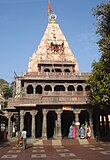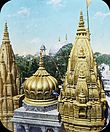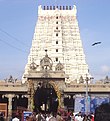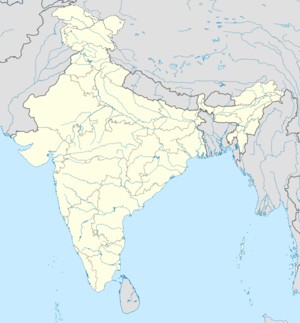Jyotirlinga
| Part of a series on |
| Shaivism |
|---|
 |
|
|
A Jyotirlinga (Sanskrit: ज्योतिर्लिङ्ग, romanized: Jyotirliṅga, lit. 'lingam of light')[1] or Jyotirlingam, is a devotional representation of the Hindu god Shiva. The word is a Sanskrit compound of IAST (IAST: IAST)
('radiance') and
IAST (IAST: IAST)
('sign'). The Śiva Mahāpurāṇam (also Shiva Purana) mentions 64 original jyotirlinga shrines in India
Hinduism[edit]
Legend[edit]
According to a Shaiva legend from the Shiva Purana, once, Brahma (the god of creation) and Vishnu (the god of preservation) had an argument over their supremacy.[2] To settle the debate, Shiva pierced the three worlds, appearing as a huge, infinite pillar of light, the jyotirlinga. Brahma and Vishnu decided to ascend and descend across a pillar of light respectively, to find the end of the light in either direction. According to some iterations, Vishnu assumed his Varaha avatar to achieve this task, while Brahma rode a hamsa (swan).[3] Brahma lied that he had discovered the end of the light, producing a ketakī flower as proof, while Vishnu admitted that he could not find the end of the light from his journey.[4] The dishonesty of Brahma angered Shiva, causing him to curse the creator deity that he would not be worshipped; he also declared that Vishnu would be eternally worshipped for his honesty.[5] The jyotirlinga shrines are regarded to be the temples where Shiva appeared as a fiery column of light.[6][7]
Original 64[edit]
Originally, there were believed to have been 64 jyotirlingas of which twelve are considered to be very auspicious and holy.[2] The twelve jyotirlinga sites take the names of their respective presiding deity, and each is considered a different manifestation of Shiva.[8] At all these sites, the primary image is lingam, representing the beginningless and endless stambha pillar, symbolising the infinite nature of Shiva.[8][9][10]
Sanskrit shlokas[edit]
The following shloka (द्वादश ज्योतिर्लिंग स्तोत्रम् Dvādaśa Jyotirliṅga Stotram) describes the 12 jyotirlingas:[11]
| Sanskrit | transliteration | translation |
|---|---|---|
| सौराष्ट्रे सोमनाथं च श्रीशैले मल्लिकार्जुनम्। | Saurāṣṭre Somanāthaṃ cha Śrīśaile Mallikārjunam | Somnath in Saurashtra and Sri Mallikarjuna in Srisailam; |
| उज्जयिन्यां महाकालमोङ्कारममलेश्वरम्॥ | Ujjayinyāṃ Mahākālam Omkāram Amaleśwaram | Mahakala (Mahakaleshwara) in Ujjain, Omkareshwara in (Khandwa); |
| वैद्यनाथं चिताभूमौ(/परल्यां वैद्यनाथं च) डाकिन्यां भीमशङ्करम्। | Vaidyanāthaṃ chitha bhumau Ḍākinyāṃ Bhīmaśaṅkaram | Baidyanath in Chitha Bhumi and Bhimashankara in Dakinya; |
| सेतुबन्धे तु रामेशं नागेशं दारुकावने॥ | Setubandhe tu Rāmeśaṃ Nāgeśaṃ Dārukāvane | Ramesham (Rameshwara) in Sethubandh, (Nagesham) and Nageshwar Jyotirling Dwarka or Naganath in Daruka-Vana; |
| वाराणस्यां तु विश्वेशं त्र्यम्बकं गौतमीतटे। | Vārāṇasyāṃ tu Viśveśaṃ Tryambakaṃ Gautamītaṭe | Vishwesham (Vishweshwara) in Varanasi, Tryambakam (Trayambakeshwara) at bank of the river Gautami (Godavari); |
| हिमालये तु केदारं घुश्मेशं च शिवालये॥ | Himālaye tu Kedāraṃ Ghuśmeśaṃ ca Śivālaye | Kedar (Kedarnath) in the Himalayas and Ghushmesh in Shivalay , (Grishneshwar / Ghushmeshwar ) |
| एतानि ज्योतिर्लिङ्गानि सायं प्रातः पठेन्नरः। | etāni jyotirliṅgāni sāyaṃ prātaḥ paṭhennaraḥ | One who recites these jyotirlingas every evening and morning |
| सप्तजन्मकृतं पापं स्मरणेन विनश्यति॥ | saptajanmakṛtaṃ pāpaṃ smaraṇena vinaśyati | is relieved of all sins committed in past seven lives. |
| एतेषां दर्शनादेव पातकं नैव तिष्ठति। | eteṣāṃ darśanādeva pātakaṃ naiva tiṣṭhati | One who visits these, gets all his wishes fulfilled |
| कर्मक्षयो भवेत्तस्य यस्य तुष्टो महेश्वराः॥: | karmakṣayo bhavettasya yasya tuṣṭo maheśvarāḥ | and one's karma gets eliminated as Maheshwara gets satisfied to the worship. |
Twelve most sacred sites[edit]
The names and the locations of 12 jyotirlingas are mentioned in the Shiva Purana ( IAST (IAST: IAST)
, Ch.42/2-4). The detailed stories are given in Kotirudra Saṁhitā, chapters 14 to 33. These temples (not in order) are:
| # | Jyotirlinga | Image | State | Location | Description |
|---|---|---|---|---|---|
| 1 | Somnath | 
|
Gujarat | Veraval, Saurashtra | Somnath is traditionally considered the first pilgrimage site: the Dwadash Jyotirlinga pilgrimage begins with the Somnath Temple. The temple, that was destroyed and re-built sixteen times, is held in reverence throughout India and is rich in legend, tradition, and history. It is located at Prabhas Patan, Veraval in Saurashtra region of Gujarat state in western India. |
| 2 | Mallikārjuna | 
|
Andhra Pradesh | Srisailam |
IAST (IAST: IAST) , also called [[Srisailam|IAST (IAST: IAST) ]], is located on a mountain in Kurnool District in Rayalaseema.[12] It enshrines Mallikarjuna in an ancient temple that is architecturally and sculpturally rich. It is a place where Shakti Peetha and jyotirlingam are together. Adi Shankara composed his Shivananda Lahari here.[citation needed] |
| 3 | Mahakaleshwar | 
|
Madhya Pradesh | Ujjain | Mahakal, Ujjain (or Avanti) in Madhya Pradesh is home to the Mahakaleshwar Jyotirlinga temple. The Lingam at Mahakal is believed to be Swayambhu, the only one of the 12 jyotirlingams to be so. It is also the only one facing south and also the temple to have a Shree Rudra Yantra perched upside down at the ceiling of the Garbhagriha (where the Shiv Lingam sits). It is a place where Shakti Peetha and jyotirlingam are together. |
| 4 | Omkareshwar | 
|
Madhya Pradesh | Khandwa | Omkareshwar is in Madhya Pradesh on an island in the Narmada River and home to a jyotirlinga shrine and the Mamaleshwar temple. |
| 11 | Kedarnath | 
|
Uttarakhand | Kedarnath | Kedarnath in Uttarakhand is revered as the northernmost and the closest jyotirlinga to Lord Shiva's eternal abode of Mount Kailash. Kedarnath forms a part of the smaller Char Dham pilgrimage circuit of Hinduism. Kedarnath, nestled in the snow-clad Himalayas, is an ancient shrine, rich in legend and tradition. It is accessible only for six months a year. It is also one of the Paadal Petra Sthalam of Vada Naadu mentioned in Thevaaram. Shiva assumed the form of wild boar and dived into the earth at Kedarnath to emerge at Doleshwor in Kathmandu Valley, Nepal. Pure ghee is applied at Kedarnath lingam as the boar was injured. |
| 6 | Bhimashankar | 
|
Maharashtra | Khed taluka, Pune | Khed taluka is also referred to as the Daakini country, hence this temple is also called Daakini temple, |
| 9 | Vishwanath | 
|
Uttar Pradesh | Varanasi | The Kashi Vishwanath (Vishweshwar) Temple in Varanasi, Uttar Pradesh is home to the Vishwanath Jyotirlinga shrine, which is perhaps the most sacred of Hindu shrines. It is also one of the Padal petra stalam of Vada Naadu mentioned in Thevaaram. The temple is situated in Varanasi, the holiest city for Hindus, where a Hindu is expected to make a pilgrimage at least once in his life, and if possible, also pour the remains of cremated ancestors on the River Ganges. The temple stands on the western bank of the holy river Ganges, and is one of the twelve jyotirlingas. In fact, it is a place where Shakti peeta and jyotirlingam are together. It is the holiest of all Shiva temples. The main deity is known by the name Vishwanath or Vishweshwara meaning Ruler of the universe. The temple town, is considered the oldest living city in the world, with 3500 years of documented history, is also called Kashi. |
| 10 | Trimbakeshwar | 
|
Maharashtra | Trimbak, near Nashik | The Trimbakeshwar Temple, near Nashik in Maharashtra, is a jyotirlinga shrine associated with the origin of the Godavari River. |
| 8 | Nageshwar | 
|
Gujarat | Near Daarukavanam | Nageshwar Jyotirlinga is one of the 12 jyotirlinga shrines mentioned in the Shiva Purana and the Dvādaśa Jyotirliṅga Stotram, says one of the jyotirlinga namely Nagesh is situated in Daruka-Vana. The Nagesh Jyotirlinga status come from - Aundha Naganath |
| 5 | Baidyanath | 
|
Jharkhand | Deoghar | According to Hindu scriptures, the demon king Ravana began the journey homeward carrying the Shivaling. On the way, he wanted to relieve himself by urination. He bid a cowherd boy to hold the Linga while he relieved himself. The cowherd was not able to bear the weight of the Linga and when he could no longer hold it, he put it down on the earth. And the Shiva Linga put there stayed as Lord Shiva already ordained and came to be known as Vaidyanatheswar. Another belief says that Baba Vaidyanath dham Temple located in Deoghar in the state of Jharkhand, India is a jyotirlinga. |
| 7 | Rameshwaram | 
|
Tamil Nadu | Rameswaram | Rameswaram in Tamil Nadu is home to the vast Ramalingeswarar Jyotirlinga temple and is revered as the southernmost of the twelve jyotirlinga shrines of India. It enshrines the
IAST (IAST: IAST) (God of Rama) pillar.[12] It is also one of the Padal petra stalam of Pandya Naadu mentioned in Tevaram. |
| 12 | Grishneshwar | 
|
Maharashtra | Aurangabad | Grishneshwar Jyotirlinga Temple, referred to as the Grishneshwar temple in Shiva Purana, is one of the 12 jyotirlinga shrines mentioned in the Shiva Purana. According to Shiv Puran, Grishneshwar is one of the Shiva Jyotirlinga which is situated near Ellora village, less than a kilometer from UNESCO site Ellora Caves in Aurangabad district of Maharashtra. |
See also[edit]
- Ardhanarishvara
- Harihara – Fused Hindu deity of Vishnu (Hari) and Shiva (Hara)
- Parikrama
- Tridevi – Hindu combining of three goddesses into one
- Trimurti – Hinduism's supreme triumvirate or triple deity of supreme divinity
- Vaikuntha Kamalaja
- Yatra – Pilgrimage in Indian religions
References[edit]
Citations[edit]
- ↑ Wisdom Library 2019
- ↑ 2.0 2.1 Venugopalam 2003, pp. 92–95
- ↑ Pattanaik 2017, p. 126
- ↑ Kumar 2003, p. 1645
- ↑ Gangashetty 2019, p. 102
- ↑ Eck 1999, p. 107
- ↑ Gwynne 2009, section on Char Dham
- ↑ 8.0 8.1 Lochtefeld 2002, pp. 324-325
- ↑ Harding 1998, pp. 158-158
- ↑ Vivekananda, v. 4
- ↑ Vaidika Vignanam n.d.
- ↑ 12.0 12.1 Chakravarti 1994, p. 140
Works cited[edit]
- Chakravarti, Mahadev (1994). The Concept of Rudra-Śiva Through The Ages (Second Revised ed.). Delhi: Motilal Banarsidass. ISBN 81-208-0053-2.
- Chaturvedi, B. K. (2006). Shiv Purana (First ed.). New Delhi: Diamond Pocket Books (P) Ltd. ISBN 81-7182-721-7.
- Eck, Diana L. (1999). Banaras, city of light (First ed.). New York: Columbia University Press. ISBN 0-231-11447-8.
- Gangashetty, Ramesh (30 October 2019). Thirtha Yatra: A Guide to Holy Temples and Thirtha Kshetras in India. Notion Press. ISBN 978-1-68466-134-3.
- Gwynne, Paul (2009). World Religions in Practice: A Comparative Introduction. Oxford: Blackwell Publication. ISBN 978-1-4051-6702-4.
- Harding, Elizabeth U. (1998). "God, the Father". Kali: The Black Goddess of Dakshineswar. Motilal Banarsidass. pp. 156–157. ISBN 978-81-208-1450-9.
- Kumar, Naresh (2003). Encyclopaedia of Folklore and Folktales of South Asia. Anmol Publications. ISBN 978-81-261-1400-9.
- Lochtefeld, James G. (2002). The Illustrated Encyclopedia of Hinduism: A-M. Rosen Publishing Group. p. 122. ISBN 0-8239-3179-X.
- Pattanaik, Devdutt (7 May 2017). Devlok 2: 2. Random House Publishers India Pvt. Limited. ISBN 978-93-86495-15-0.
- "Dwadasa Jyotirlinga Stotram". Vaidika Vignanam (in संस्कृतम्). n.d.
- Venugopalam, R. (2003). Meditation: Any Time Any Where (First ed.). Delhi: B. Jain Publishers (P) Ltd. ISBN 81-8056-373-1.
- Vivekananda, Swami. "The Paris Congress of the History of Religions". The Complete Works of Swami Vivekananda. Vol. 4.
- "Jyotirlinga, Jyotirliṅga, Jyotis-linga, Jyotirlimga: 5 definitions". Wisdom Library. 28 December 2019. Retrieved 13 November 2022.
External links[edit]
Template:Shankara mathas Template:Puranas Template:Hindu holy cities

